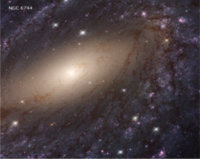Space Station Info :: Research and Technology
Astronomers Release Most Complete Ultraviolet-Light Survey of Nearby Galaxies
Capitalizing on the unparalleled sharpness and spectral range of NASA's Hubble Space Telescope, an international team of astronomers is releasing the most comprehensive, high-resolution ultraviolet-light survey of nearby star-forming galaxies. The Hubble Space Telescope is a project of international cooperation between NASA and ESA (European Space Agency). The researchers combined new Hubble observations with archival Hubble images for 50 star-forming spiral and dwarf galaxies in the local universe, offering a large and extensive resource for understanding the complexities of star formation and galaxy evolution. The project, called the Legacy ExtraGalactic UV Survey (LEGUS), has amassed star catalogs for each of the LEGUS galaxies and cluster catalogs for 30 of the galaxies, as well as images of the galaxies themselves. The data provide detailed information on young, massive stars and star clusters, and how their environment affects their development. The LEGUS survey will also help astronomers interpret views of galaxies in the distant universe, where the ultraviolet glow from young stars is stretched to infrared wavelengths due to the expansion of space
"There has never before been a star cluster and a stellar catalog that included observations in ultraviolet light," explained survey leader Daniela Calzetti of the University of Massachusetts, Amherst. "Ultraviolet light is a major tracer of the youngest and hottest star populations, which astronomers need to derive the ages of stars and get a complete stellar history. How stars form is still a vexing question in astronomy. "Much of the light we get from the universe comes from stars, and yet we still don't understand many aspects of how stars form," said team member Elena Sabbi of the Space Telescope Science Institute in Baltimore, Maryland. "This is even key to our existence — we know life wouldn't be here if we didn't have a star around." The Hubble data provide all of the information to analyze these galaxies, the researchers explained. "We also are offering computer models to help astronomers interpret the data in the star and cluster catalogs," Sabbi said.


The research team carefully selected the LEGUS targets from among 500 galaxies, compiled in ground-based surveys, located between 11 million and 58 million light-years from Earth. Team members chose the galaxies based on their mass, star-formation rate, and abundances of elements that are heavier than hydrogen and helium. The catalog of ultraviolet objects collected by NASA's Galaxy Evolution Explorer (GALEX) spacecraft also helped lay the path for the Hubble study. The team used Hubble's Wide Field Camera 3 and the Advanced Camera for Surveys over a one-year period to snap visible- and ultraviolet-light images of the galaxies and their most massive young stars and star clusters. The researchers also added archival visible-light images to provide a complete picture.
The star cluster catalogs contain about 8,000 young clusters whose ages range from 1 million to roughly 500 million years old. These stellar groupings are as much as 10 times more massive than the largest clusters seen in our Milky Way galaxy. The star catalogs comprise about 39 million stars that are at least five times more massive than our Sun. Stars in the visible-light images are between 1 million and several billion years old; the youngest stars, those between 1 million and 100 million years old, shine prominently in ultraviolet light.




